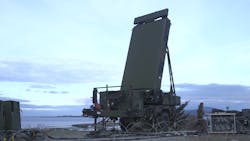Marine Corps orders 30 G/ATOR radars to watch for low-observable threats in near-billion-dollar contract
QUANTICO MARINE BASE, Va. – U.S. Marine Corps surveillance experts are ordering 30 versions of a new radar system designed to protect Marines on attack beaches from rockets, artillery, mortars, cruise missiles, unmanned aerial vehicles (UAVs), and other low observables under terms of a contract worth nearly a billion dollars.
Officials of the Marine Corps Systems Command at Quantico Marine Base, Va., announced a $958 million contract Friday to the Northrop Grumman Corp. Mission Systems segment in Linthicum, Md., for 30 full-rate production versions of the Ground/Air Task-Oriented Radar (G/ATOR).
G/ATOR is an expeditionary, three-dimensional, short-to-medium-range, multi-role radar system designed to detect low-observable targets with low radar cross sections such as rockets, artillery, mortars, cruise missiles, and UAVs. Marine Corps leaders are developing and fielding G/ATOR in three blocks for use by the Marine Air Ground Task Force across the range of military operations, officials say.
The Northrop Grumman G/ATOR radar is designed to protect deployed Marine Corps warfighters on invasion beaches from rockets, artillery, mortars, cruise missiles, and UAVs. This procurement also includes spares parts and retrofit kits.
Northrop Grumman built G/ATOR for short-range air defense (SHORAD) and tactical air operations Center (TAOC) air surveillance missions, including identification friend-or-foe (IFF). The increment I design was to provide for growth to all following increments without equipment re-design and provide an open architecture to enable upgrades with following increments.
The G/ATOR program was to showcase new component technologies, including the VPX embedded computing fast switch-fabric interconnect. As part of the G/ATOR program's first increment, Northrop Grumman awarded a $4.3 million contract in 2008 to the Curtiss-Wright Corp. Defense Solutions segment in Ashburn, Va., for VPX-based embedded computers for radar signal processing, to be delivered by 2010.
The Ground Weapons Locating Radar (GWLR) portion of G/ATOR uses active electronically scanned array (AESA) radar technology to provide several different radar missions and adapt automatically to changing battlefield conditions.
On this contract Northrop Grumman will do the work in Linthicum, Md.; Syracuse, East Syracuse, and Farmingdale, N.Y.; Stafford Springs, Conn.; Tulsa, Okla.; Valencia and San Diego, Calif.; Richardson, Texas; St. Paul, Minn.; Lowell, Mass.; Littleton, Colo.; and Durham, N.C., and should be finished by January 2025.
For more information contact Northrop Grumman Mission Systems online www.northropgrumman.com.

John Keller | Editor-in-Chief
John Keller is the Editor-in-Chief, Military & Aerospace Electronics Magazine--provides extensive coverage and analysis of enabling electronics and optoelectronic technologies in military, space and commercial aviation applications. John has been a member of the Military & Aerospace Electronics staff since 1989 and chief editor since 1995.

